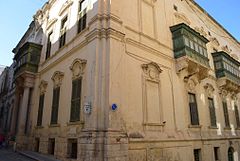Admiralty House (Valletta)
| Admiralty House | |
|---|---|

Façade of Admiralty House
|
|
| Former names | Casa Miari Palazzo Don Raimondo and several other names |
| General information | |
| Status | Intact |
| Type | Palace |
| Architectural style | Baroque |
| Location | Valletta, Malta |
| Coordinates | 35°53′54″N 14°30′33″E / 35.89833°N 14.50917°ECoordinates: 35°53′54″N 14°30′33″E / 35.89833°N 14.50917°E |
| Current tenants | National Museum of Fine Arts |
| Construction started | 1569–1570 |
| Renovated | 1761–1763 |
| Owner | Government of Malta |
| Technical details | |
| Material | Limestone |
| Floor count | 2 |
| Design and construction | |
| Architect | Andrea Belli |
Admiralty House (Maltese: id-Dar tal-Ammirall), formerly known as Casa Miari, Palazzo Don Raimondo and by several other names, is a palace in Valletta, Malta. It was originally built in 1569–70 as two private houses by Fra Jean de Soubiran dit Arafat, a knight of the Order of St. John. The houses were later leased to various owners, including Fra Raimondo de Sousa y Silva, who rebuilt them a single residence between 1761 and 1763.
In 1808, Louis Charles, Count of Beaujolais was received at the house, where he died of tuberculosis. From 1821 to 1961, the building was the official residence of the Commander-in-Chief of the Mediterranean Fleet, hence its name. The building housed the National Museum of Fine Arts from 1974 to 2016. Currently there are plans to restore Admiralty House and convert it into the Office of the Attorney General.
The site of the Admiralty House was originally occupied by two houses which were built by the French knight Fra Jean de Soubiran dit Arafat in 1569–70. The properties passed down to another knight François le Petit de la Guerche, and were taken over by the Treasury of the Order of St. John upon his death in 1663. From 1668 onwards, the houses were leased to various knights.
In the 1760s, the two houses were occupied by Fra Raimondo de Sousa y Silva, a wealthy Portuguese knight who was the Balì of Lessa. The Treasury rebuilt the houses to their present form between 1761 and 1763 so as to better accommodate the Balì, and the building became known as Palazzo Don Raimondo after him. The reconstruction is attributed to Andrea Belli, the architect who also redesigned Auberge de Castille. The building was constructed from limestone quarried at Floriana.
De Sousa died in 1782, and from 1783 to 1785 the house was divided into several apartments. It was subsequently converted back to a single residence, and was again let to a number of knights. Throughout its history, the house was known by a number of names depending on its occupants, including Maison Arifat, Casa de Guerche and Maison Fleurigny. In the late 18th and early 19th century, it was known as Casa Miari after Fra Antonio Miari di Belluno, Secretary to Grand Master Ferdinand von Hompesch zu Bolheim, who lived in the house from 1795 to 1798.
...
Wikipedia
